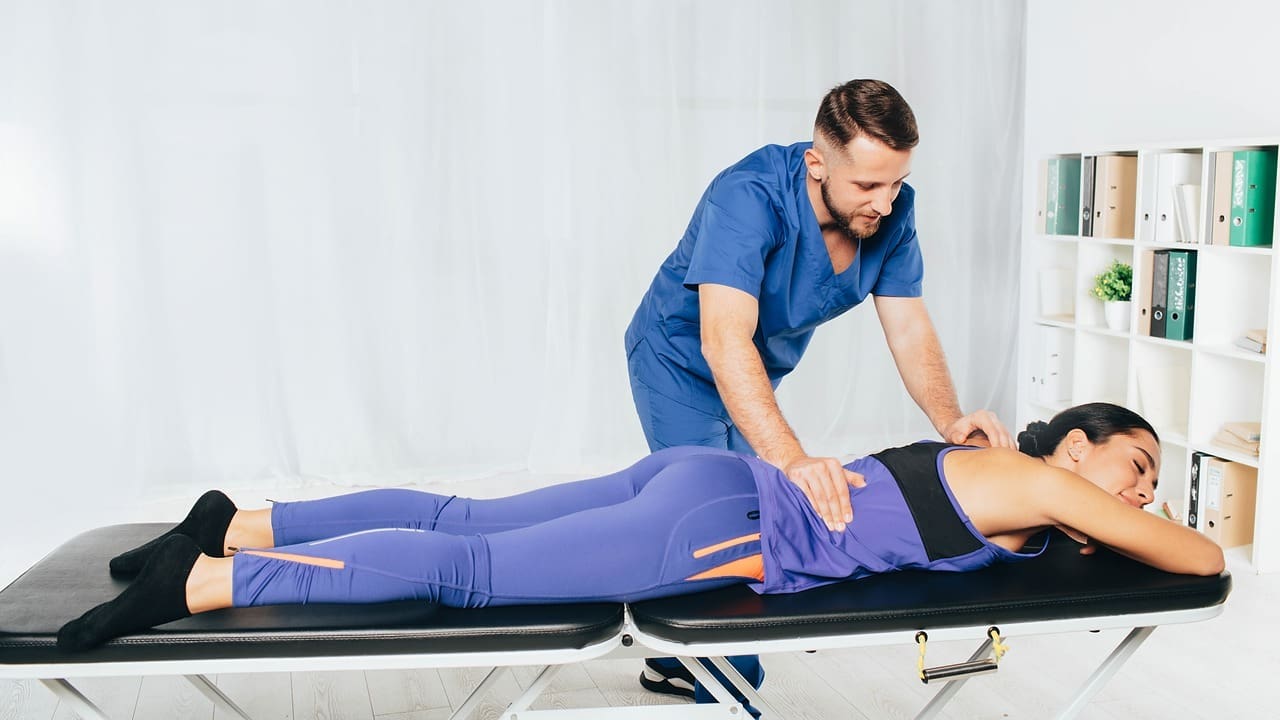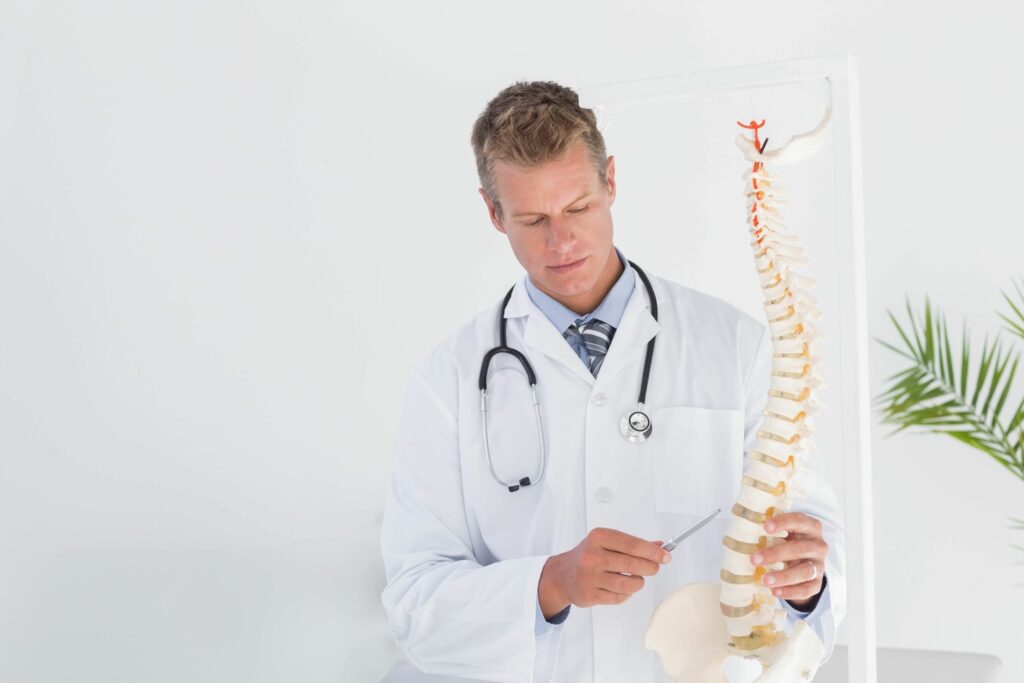Last Updated on November 4, 2025 by mcelik

Spinal compression is more than just a discomfort; it can affect your health and life quality. At Liv Hospital, our team of experts is here to help. We focus on compressed cervical vertebrae symptoms and use effective treatments like non-surgical spinal decompression therapy.
We offer a variety of effective treatment options, from non-surgical methods to surgery, as recommended by the Cleveland Clinic. It’s vital to seek medical help early to avoid more serious problems and get better results.

Spinal compression happens when the spinal cord or nerves get pressed. This can cause health problems. We’ll explore how this pressure affects the spinal nerves and discs. We’ll also look at the differences between sudden and long-term compression.
When the spine is compressed, nerves can get pinched. This leads to pain, numbness, and weakness. The discs, which cushion the vertebrae, can also get affected. This might cause them to herniate or get compressed further.
Acute spinal compression comes from sudden injuries, like falls or car accidents. Symptoms appear right away. Chronic compression, though, develops slowly. It’s often due to conditions like osteoarthritis or spinal stenosis.
| Characteristics | Acute Compression | Chronic Compression |
|---|---|---|
| Cause | Sudden injury | Degenerative conditions |
| Onset | Immediate | Gradual |
| Symptoms | Severe pain, numbness | Progressive pain, weakness |

Spinal compression can show itself in many ways that need quick action. Knowing these signs is key to avoiding more harm and getting the right treatment.
Pain, numbness, and weakness in the back, neck, or limbs are early signs. It’s vital to spot these symptoms early to stop the problem from getting worse. A study on degenerative lumbar spine diseases found that back and leg pain are big concerns.
The symptoms of spinal compression change based on where the compression is. We’ll look at how different parts of the spine are affected.
In the cervical area, compression can cause neck pain, numbness or tingling in the arms, and hand weakness. These symptoms can really affect your daily life and should not be ignored.
In the thoracic and lumbar areas, compression can lead to back pain, pain that shoots down the legs (sciatica), and in severe cases, cauda equina syndrome. Spotting these warning signs early is critical for managing the condition well.
“The key to managing spinal compression is early detection and proper action,” say medical experts. We must watch for these signs and get medical help when needed.
Compressed cervical vertebrae can cause many symptoms that affect daily life. The neck pain can spread to other parts of the body. This leads to discomfort and makes it hard to function.
Neck pain is a common symptom of compressed cervical vertebrae. This pain can stay in the neck or spread to the shoulders, arms, or hands. The pain’s pattern depends on the level and severity of the compression.
Numbness or tingling in the hands is another big symptom. These feelings happen because nerves are compressed. This can also cause weakness and make it hard to do everyday tasks.
Cervical compression can really affect daily life. Simple tasks like getting dressed or writing can become hard. “The impact on daily life can be substantial, making timely diagnosis and treatment critical.” As one study points out,
“Early intervention can significantly improve outcomes for patients with cervical cord compression.”
So, it’s important to understand the symptoms and get medical help early.
The lumbar region of the spine is prone to compression. This can cause severe symptoms. Compression happens when nerves or the spinal cord in the lower back get squished. This is often due to herniated discs, spinal stenosis, or fractures.
Pain in the lower back is a key sign of lumbar spine compression. This pain can feel like a dull ache or sharp stabbing. Pressure on nerves can also cause numbness, tingling, or weakness in the legs. It’s important to recognize fracture morphology and spinal stenosis to diagnose this condition.
Sciatica is a common symptom of lumbar spine compression. It’s pain that spreads along the sciatic nerve from the lower back to the legs. This pain can be very severe and may be accompanied by numbness or tingling.
Cauda equina syndrome is a severe complication of lumbar spine compression. It happens when nerves in the lower spine get compressed. Symptoms include severe leg pain, numbness, and problems with the bladder or bowel. Immediate medical attention is required to prevent long-term damage.
It’s vital to recognize the signs of lumbar spine compression early. If you have persistent lower back pain, sciatica, or numbness in the legs, see a healthcare professional. They can provide the right diagnosis and treatment.
Compression cord syndromes are serious and need quick attention and the right diagnosis. When the spinal cord gets compressed, it can cause many symptoms. We will look at the different types and their effects.
Central cord syndrome makes arms weaker or paralyzed more than legs. It often happens after a hyperextension injury in people with cervical spine stenosis. Urgent evaluation is necessary to find the best treatment.
Ventral cord compression puts pressure on the front of the spinal cord. Symptoms include weakness or paralysis in both legs below the compression. There can also be loss of bladder and bowel control. Prompt medical intervention is key to avoid lasting damage.
Brown-Séquard syndrome happens when half of the spinal cord is damaged. It causes weakness or paralysis on one side and loss of pain and temperature on the other. Knowing these patterns helps doctors diagnose and treat cord compression better.
Diagnosing spinal compression needs a mix of advanced imaging and detailed neurological checks. We use these tools to see how bad the compression is and plan the best treatment.
Imaging is key in finding spinal compression. MRI (Magnetic Resonance Imaging) shows soft tissues like discs and nerves. This helps spot compression areas. CT (Computed Tomography) scans give clear views of bones. X-rays help check spinal alignment and bone health.
Checking nerves and muscles is vital. We do detailed tests to see how spinal compression affects nerves. This helps us understand how bad the compression is and plan the right treatment.
Electromyography (EMG) and Nerve Conduction Studies (NCS) are important for finding nerve damage. These tests show how much compression there is and if treatment is working.
Spinal compression treatment needs a mix of methods to tackle pain and its causes. We’ll look at eight effective ways doctors treat it. These methods aim to ease symptoms and help patients get better.
First, doctors often try conservative management. This includes physical therapy, making lifestyle changes, and adjusting workspaces to ease spine pressure. Physical therapy is key, with exercises to strengthen spine muscles, improve flexibility, and correct posture.
Doctors use medicines to manage pain and swelling from spinal compression. Over-the-counter pain relievers like NSAIDs are common. For severe cases, corticosteroids can be used to shrink swelling and ease pain. The National Institutes of Health says meds are a big part of treatment.
If other treatments don’t work, doctors might suggest interventional procedures. These include:
Epidural steroid injections put corticosteroids near the spinal cord. This cuts down inflammation and eases pain.
Nerve blocks inject medicine into nerves to stop pain signals. Radiofrequency ablation uses heat to damage nerves, giving longer pain relief.
| Treatment Approach | Description | Benefits |
|---|---|---|
| Conservative Management | Includes physical therapy, lifestyle changes, and ergonomic adjustments | Non-invasive, reduces pressure on the spine |
| Medication | NSAIDs, corticosteroids for pain and inflammation | Effective for managing pain and reducing inflammation |
| Epidural Steroid Injections | Corticosteroids injected into the epidural space | Reduces inflammation, relieves pain |
| Nerve Blocks and Radiofrequency Ablation | Injecting medication or using radiofrequency to lesion nerves | Blocks or reduces pain signals |
Knowing these treatment options helps patients make better choices. It’s vital to talk to doctors to find the best plan for spinal compression.
Non-surgical spinal decompression therapy is a top choice for those with spinal compression. It’s great for people with disc herniations. It’s a safe, non-surgical way to treat the problem.
Traction-based methods are key in non-surgical spinal decompression therapy. They gently stretch the spine. This helps take pressure off the discs and allows herniated material to move back into place, helping it heal.
Research shows that non-surgical spinal decompression therapy can greatly improve symptoms in up to 86% of patients with disc herniations. This success rate highlights how well this treatment works.
Treatment for non-surgical spinal decompression therapy usually involves many sessions. The length of treatment depends on how bad the condition is and how well the patient responds. Patients often need several weeks of therapy, with regular checks to see how they’re doing.
Knowing the benefits and success rates of non-surgical spinal decompression therapy helps patients make better choices. This therapy is a safe and effective way to help those with compressed spine conditions.
Physical therapy is a key treatment for compressed spinal nerves. It helps a lot by making symptoms better and improving life quality. A good physical therapy plan can really help.
Exercises are very important for nerve decompression. Specific stretching and strengthening exercises can lessen nerve pressure. This helps in healing and reduces pain.
For example, exercises that make the spine more flexible and strengthen muscles around it are very helpful.
Manual therapy is a big part of physical therapy for compressed spinal nerves. Spinal mobilization and manipulation help improve spinal alignment. They also reduce stiffness and relax muscles.
Teaching patients about proper posture and body mechanics is key. It helps prevent more compression and aids in long-term recovery. By learning these, patients can make lifestyle changes to avoid future problems.
Experts say, “A detailed physical therapy program with exercises, manual therapy, and posture correction greatly improves outcomes for patients with compressed spinal nerves.”
Compression of the spinal cord might need surgery to ease pressure and stop further damage. If other treatments don’t work, surgery is key to fix spinal health and function.
Laminectomy and laminotomy are surgeries to take pressure off the spinal cord. Laminectomy removes the whole lamina, while laminotomy just takes a piece. These surgeries help free up the spinal cord and nerves.
Discectomy is a surgery to ease pressure from a herniated disc. The aim is to take out the part of the disc pressing on the spinal cord or nerves. This helps reduce pain and other symptoms.
Spinal fusion joins two or more vertebrae together. It’s needed when the spine is unstable due to compression. It keeps the spine aligned and protects the spinal cord from more harm.
Minimally invasive surgeries are changing how we treat spinal cord compression. They use smaller cuts and cause less damage. They’re chosen when it’s right for the patient’s situation and the doctor’s advice.
Choosing surgery is a big decision for patients. Our team offers full care and support during treatment. We aim for the best results for those having surgery for spinal cord compression.
Rehabilitation is key to helping patients regain strength and mobility after spinal compression treatment. It’s important for a good recovery and improving life quality.
After spinal compression treatment, patients need to follow certain care guidelines for a smooth recovery. Nonsurgical treatments often include rest, then gentle exercises. It’s important to follow your healthcare provider’s advice to avoid problems and help healing.
Exercise programs are vital for getting back strength, flexibility, and movement. These programs start with gentle stretches and then get more intense. We work with physical therapists to create personalized plans for each patient.
It’s important to make lifestyle changes to prevent spinal compression from happening again. This includes staying at a healthy weight, improving posture, and exercising regularly. We also suggest being mindful of your body mechanics and taking breaks to rest and stretch, if your job involves heavy lifting or bending.
Ergonomics play a big role in preventing spinal compression from happening again. It’s important to have a workspace that promotes good posture and reduces spine strain. We advise adjusting your workspace to fit your needs, considering chair height, monitor position, and keyboard placement.
Core strengthening is a key part of spinal rehabilitation. Strengthening muscles in the back, abdomen, and pelvis helps stabilize the spine and lowers the risk of future compression. We suggest adding exercises like planks, bridges, and pelvic tilts to your daily routine.
| Exercise | Description | Frequency |
|---|---|---|
| Plank | Hold a position with your hands under shoulders, toes on ground, and body in a straight line | 3 sets, 30 seconds each |
| Bridge | Lie on your back with knees bent, feet flat on ground; lift hips towards ceiling | 3 sets, 10 reps |
| Pelvic Tilt | Lie on your back with knees bent, feet flat on ground; tilt pelvis upwards and then back down | 3 sets, 10 reps |
Spinal health is key to feeling good overall. Knowing the dangers of spinal cord compression is important. It’s a serious issue because it can cause permanent damage to the nerves.
There are many ways to treat spinal cord compression. This includes non-surgical methods, medicines, and even surgery. Getting the right treatment can make a big difference in how you feel and live.
It’s important to know the signs of spinal cord compression and get help fast. This can help avoid serious problems and improve how well you feel. Taking care of your spine is important for your overall health.
Symptoms include neck or back pain, numbness, and tingling. You might also feel weakness in your arms or legs. Reduced coordination is another sign.
The symptoms depend on where the compression is. It can be in the cervical, thoracic, or lumbar regions.
Doctors use MRI, CT, and X-rays for imaging. They also do physical exams and tests like electromyography. These help find out how bad the compression is.
Treatment varies. It can start with pain medication and physical therapy. Sometimes, injections or surgery is needed.It depends on how severe the compression is and what’s causing it.
Yes, many cases can be treated without surgery. This includes physical therapy and medication. It works best for less severe cases.
It’s a treatment that uses traction to relieve pressure. It’s good for disc herniations, with an 86% success rate.
Physical therapy uses exercises to help nerves. It also includes manual therapy and teaching good posture. This helps prevent further strain.
Recovery is key to success. It helps prevent the problem from coming back. It includes exercises and lifestyle changes.
It’s a serious condition with severe back pain and sciatica. You might also feel numbness in your legs and have trouble with your bladder or bowel.It needs immediate medical attention.
Where the compression is affects symptoms. Cervical compression can cause neck pain and numb hands. Lumbar compression leads to lower back pain and leg symptoms.
It’s a medical emergency because it can cause permanent damage. This includes paralysis and loss of bladder or bowel control. Quick treatment is essential.
They’re conditions caused by spinal cord compression. Examples include central cord syndrome and Brown-Séquard syndrome. Each has its own symptoms and needs urgent treatment.
Yes, making healthy lifestyle choices can help. This includes keeping a healthy weight, improving your posture, exercising regularly, and avoiding heavy lifting.
Subscribe to our e-newsletter to stay informed about the latest innovations in the world of health and exclusive offers!
WhatsApp us